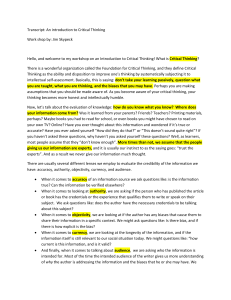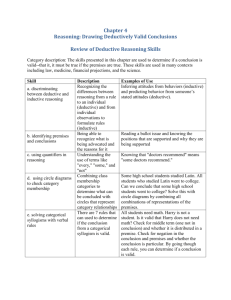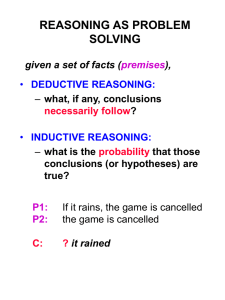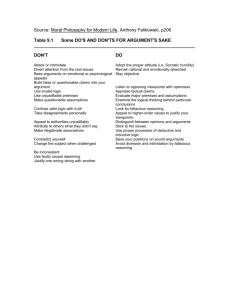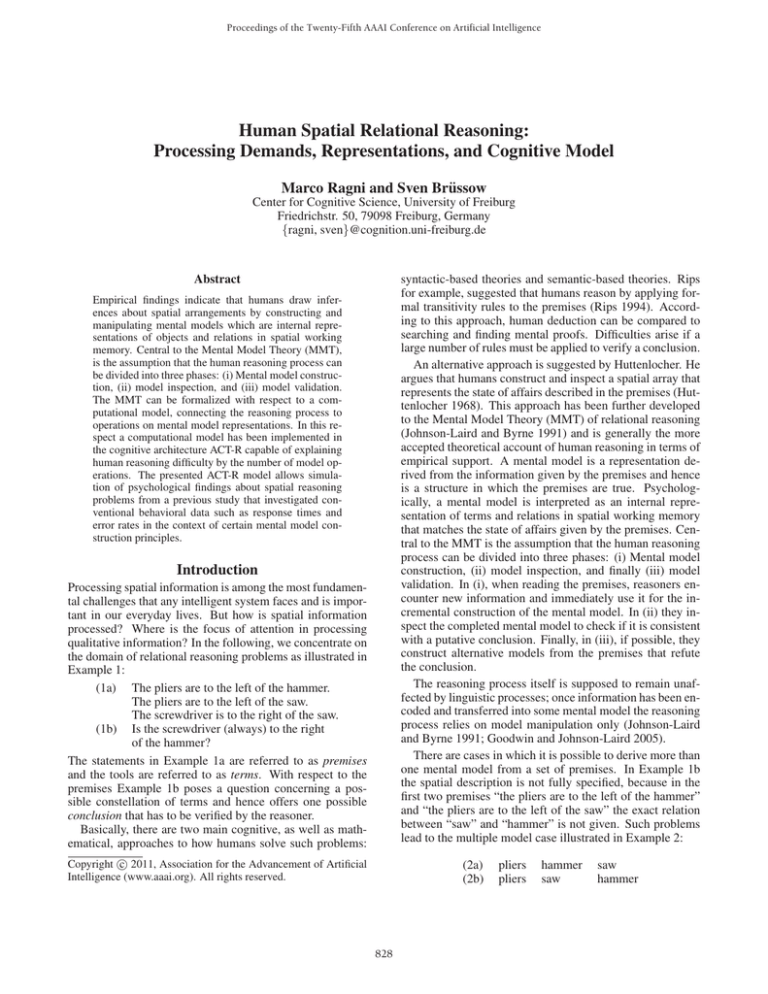
Proceedings of the Twenty-Fifth AAAI Conference on Artificial Intelligence
Human Spatial Relational Reasoning:
Processing Demands, Representations, and Cognitive Model
Marco Ragni and Sven Brüssow
Center for Cognitive Science, University of Freiburg
Friedrichstr. 50, 79098 Freiburg, Germany
{ragni, sven}@cognition.uni-freiburg.de
syntactic-based theories and semantic-based theories. Rips
for example, suggested that humans reason by applying formal transitivity rules to the premises (Rips 1994). According to this approach, human deduction can be compared to
searching and finding mental proofs. Difficulties arise if a
large number of rules must be applied to verify a conclusion.
An alternative approach is suggested by Huttenlocher. He
argues that humans construct and inspect a spatial array that
represents the state of affairs described in the premises (Huttenlocher 1968). This approach has been further developed
to the Mental Model Theory (MMT) of relational reasoning
(Johnson-Laird and Byrne 1991) and is generally the more
accepted theoretical account of human reasoning in terms of
empirical support. A mental model is a representation derived from the information given by the premises and hence
is a structure in which the premises are true. Psychologically, a mental model is interpreted as an internal representation of terms and relations in spatial working memory
that matches the state of affairs given by the premises. Central to the MMT is the assumption that the human reasoning
process can be divided into three phases: (i) Mental model
construction, (ii) model inspection, and finally (iii) model
validation. In (i), when reading the premises, reasoners encounter new information and immediately use it for the incremental construction of the mental model. In (ii) they inspect the completed mental model to check if it is consistent
with a putative conclusion. Finally, in (iii), if possible, they
construct alternative models from the premises that refute
the conclusion.
The reasoning process itself is supposed to remain unaffected by linguistic processes; once information has been encoded and transferred into some mental model the reasoning
process relies on model manipulation only (Johnson-Laird
and Byrne 1991; Goodwin and Johnson-Laird 2005).
There are cases in which it is possible to derive more than
one mental model from a set of premises. In Example 1b
the spatial description is not fully specified, because in the
first two premises “the pliers are to the left of the hammer”
and “the pliers are to the left of the saw” the exact relation
between “saw” and “hammer” is not given. Such problems
lead to the multiple model case illustrated in Example 2:
Abstract
Empirical findings indicate that humans draw inferences about spatial arrangements by constructing and
manipulating mental models which are internal representations of objects and relations in spatial working
memory. Central to the Mental Model Theory (MMT),
is the assumption that the human reasoning process can
be divided into three phases: (i) Mental model construction, (ii) model inspection, and (iii) model validation.
The MMT can be formalized with respect to a computational model, connecting the reasoning process to
operations on mental model representations. In this respect a computational model has been implemented in
the cognitive architecture ACT-R capable of explaining
human reasoning difficulty by the number of model operations. The presented ACT-R model allows simulation of psychological findings about spatial reasoning
problems from a previous study that investigated conventional behavioral data such as response times and
error rates in the context of certain mental model construction principles.
Introduction
Processing spatial information is among the most fundamental challenges that any intelligent system faces and is important in our everyday lives. But how is spatial information
processed? Where is the focus of attention in processing
qualitative information? In the following, we concentrate on
the domain of relational reasoning problems as illustrated in
Example 1:
(1a) The pliers are to the left of the hammer.
The pliers are to the left of the saw.
The screwdriver is to the right of the saw.
(1b) Is the screwdriver (always) to the right
of the hammer?
The statements in Example 1a are referred to as premises
and the tools are referred to as terms. With respect to the
premises Example 1b poses a question concerning a possible constellation of terms and hence offers one possible
conclusion that has to be verified by the reasoner.
Basically, there are two main cognitive, as well as mathematical, approaches to how humans solve such problems:
c 2011, Association for the Advancement of Artificial
Copyright Intelligence (www.aaai.org). All rights reserved.
(2a)
(2b)
828
pliers
pliers
hammer
saw
saw
hammer
Both models in Example 2 fulfill the premises. Cognitive
difficulty arises with the number of models which have to
be maintained simultaneously (Johnson-Laird 2001). In this
paper we work out the main assumptions found in the literature on human spatial (relational) reasoning and undertake
a formalization of this in a computational model.
integrated in the course of processing a previous premise.
The current term is then processed applying the first-free-fit
principle (fff) and not the first-fit principle (ff) which would
require preceding term shifting within the mental model.
The fff-principle is hypothesized to be less expensive because it just skips occupied positions and requires no additional term shifting operations. Depending on the number of
premises and terms a mixture of applicable principles is possible. Some terms may satisfactorily be integrated into the
current mental model by the fff-principle. For other terms
it may be necessary to apply the ff-principle. We refer to
mental model construction that involves both principles as
mix-principle. The processing costs for the mix-principle
are accordingly hypothesized to be lower than a those of
a model constructed merely by the ff-principle, but higher
than in the mere fff-principle case.
State-of-the-Art
Implementations of the MMT. From an AI perspective a
formalization or implementation is necessary. A first algorithm implementing the MMT was presented by (JohnsonLaird and Byrne 1991). This algorithm is able to parse relational premises and identify objects within a coordinate
system. Another model, the UNICORE model (Bara, Bucciarelli, and Lombardo 2001), has a similar implementation:
The model is based on three considerations: A model must
(i) include a grid of positions that are assigned to tokens
(terms). Tokens must (ii) have a name, and some terms may
(iii) stand in a certain relation to each other.
The cognitive architecture SOAR (Laird, Newell, and
Rosenbloom 1987; Newell 1990) ”uses neither mental logic
nor mental models [. . . ] but instead does a search through
a space of possible inferences” (Thagard 2005). A different
approach using mental models considers linguistic processes
as central to the spatial reasoning process (Polk and Newell
1995). There are, to our knowledge, no implementations
covering reasoning with preferred mental models.
Spatial Reasoning by Models (SRM). SRM is an approach that specifies a computational model implementing
the PMMT (Ragni, Knauff, and Nebel 2005). An SRMmodel consists of an (i) input device for the premises, (ii) a
two-dimensional spatial array in which the mental model is
constructed, inspected, and varied, and (iii) a focus that performs all operations and that can be compared to the read/write head of the Turing machine. The focus operator performs all operations and is controlled by functions in which
strategies for insertion principles can be defined. The SRMmodel is able to explain experimental results by applying a
standard cost measure for each necessary model operation
(Ragni et al. 2007). Model predictions have been tested empirically (Ragni et al. 2007).
In the following, we illustrate how predictions by the
SRM-model can be further evaluated. As this model shares
features with the Turing machine we aimed for an implementation in a cognitive architecture that is able to reproduce behavioral findings. With the data at hand the SRM
-model can be tested and at the same time provides a measure that accounts for cognitive complexity.
Preferred Mental Model Theory. The approach we follow here is referred to as the Preferred Mental Model Theory
(PMMT). The PMMT argues that in multiple model cases,
human reasoners initially construct only one Preferred Mental Model (PMM). The PMM is easier to construct and easier
to maintain in working memory compared to all other possible mental models (Rauh et al. 2005). Only if necessary in
the model variation phase, is the PMM is varied to find alternative interpretations of the premises and thus accounts for
the principle of economicity (Manktelow 1999). Consider
the following sequence of abstract premises in Example 3:
(3)
A is to the left of B
B is to the left of C
B is to the left of D
D is to the left of E
The Cognitive Architecture ACT-R. ACT-R is a modular theory and architecture of cognition with an underlying
production system as procedural backbone. Production rules
operate on symbolic representations of declarative memory
items – so-called chunks (Anderson 2007). Modules are
characterized by their functionality and each ACT-R module has an associated interface called buffer that allows the
exchange information across modules. Both buffers and productions underlie a strict capacity limitation: Each module can keep only one chunk in a buffer at a time and
only one production may be selected to modify the chunks.
Any buffer manipulation is therefore a strictly serial process. Modules, however, may be active in parallel and consequently more than one chunk may be processed at a time,
hence parallelism across modules is allowed.
On the sub-symbolic side, probabilistic processes direct
behavior such as production selection from procedural and
chunk selection from declarative memory. In example, the
availability of chunks to the corresponding retrieval buffer
The resulting mental models that may later be inspected to
check some putative conclusion will differ from each other
depending on the applied construction principle.
Table 1: Integration principles.
Principle
Free first fit (fff)
Mix
First fit (ff)
Mental model
ABCDE
ABDCE
ABDEC
Processing demands
low
medium
high
Terms of the current premises are successively integrated
only at free positions. This means that a position is skipped
if it is already occupied with some other term that has been
829
We set Transf1 (PMM(Φ), o, Φ) = {B | B |= Φ and B =
imgo (A)}, the set of all models of Φ which can be derived
by applying o at A.
Definition 2 For premises Φ, set of operators O and a preferred model PMM(Φ), the preferred consequence relation
is
Φ |=p Ψ ⇔ PMM(Φ) |= Ψ and for each B |= Φ
with B ∈ Transf1 (PMM(Φ), O)
holds B |= Ψ.
depends on their level of activation, which is calculated on
the basis of several aspects. Most notably, once a chunk has
been created its initial activation starts decreasing following
a fixed decay rate. Chunks may, however, receive additional
activation determined by (i) the number of positive retrievals
in the past and (ii) spreading activation from the chunk in the
goal buffer per default.
Visual information provided by the environment is processed in the vision-module. The goal formulation is constructed in the goal module and for keeping and generating
problem-specific sub goals the imaginal module is used.
The restricted consequence relation |=kp reflects that
humans might apply only a fixed number of operations
and generate only a finite number of alternative models.
There is empirical evidence for this (Ragni et al. 2007).
Transfk (PMM(Φ), o, Φ) describes the sequence of k applications of o at Φ.
Definition 3 For premises Φ, set of operators O and a preferred model PMM(Φ), the restricted consequence relation
is
Φ |=kp Ψ ⇔ PMM(Φ) |= Ψ and for each B |= Φ
with B ∈ Transfk (PMM(Φ), O)
holds B |= Ψ.
Formalization
A relational structure is a tuple (D, Ri∈I ) for an index set
I consisting of a domain D – sometimes called discourse
universe – and a set of usually binary relations Ri . For example, an expression The cinema is left of the church can be
expressed by arrangement relations L, R, etc. over the domain of buildings. Complex expressions can be formed by
using connectives like conjunctions and disjunctions (The
cinema is to the left of the church and the church is in New
York). A model A is consistent with a set of premises Φ
over a relational language L (mathematically A |= Φ with
|= denoting the consequence relation) if all expressions of
Φ are true in A. Then a conclusion Ψ can be derived from
the premise set Φ (mathematically Φ |= Ψ) if the following
equivalence relations hold:
Φ |= Ψ
⇔
⇔
Computational Model
The previous considerations allow us to outline a first computational model. Such a model can be regarded as a necessary condition to the introduction of a complexity measure
and will be defined as a quadruple (I, O, F, C), with:
I, the input mechanism. This process reads the premises
from an external device. We assume that there is an external “parser” that supplies the correct meaning (Goodwin
and Johnson-Laird 2005).
O, the set of object names.
F , the spatial focus. The focus operates on a spatial array
and is initially set to position (0, 0). It can move right, left,
forward and backward (Vandierendonck, Dierckx, and De
Vooght 2004).
C, the control process. This process is responsible for the
control of the focus and other executive functions.
We ignore natural language processing components for
spatial inference expressions because these are not central
to the actual reasoning process in the mental model theory
(Johnson-Laird and Byrne 1991). In addition, there is no
principle reason that premises have to be presented as sentences. A theory that expects input from an external language processing device is more flexible; it can also account for data from experiments in which premises were
presented as figures rather than verbally (Fangmeier et al.
2006). The third and fourth components of our definition
reflect the main theoretical assumptions of our theory (cf.
Figure 1). The third component states that a model is represented in spatial working memory, which is conceptualized
as a spatial array. The spatial array is a two-dimensional
grid structure, in which the terms can be inserted, moved,
and removed by the fourth component, the focus. This focus
(a similar concept was proposed by (Vandierendonck, Dierckx, and De Vooght 2004)) is a manipulation device able to
perform all operations on the spatial array.
All models of Φ are models of Ψ.
There is no model A with A |= Φ and
A |= ¬Ψ.
A model A with the properties (i) A |= Φ and (ii) A |=
¬Ψ is called a counter-example. It follows from (ii) that if
there is a counter-example to Φ and Ψ then Φ |= Ψ cannot
hold.
The classical (mathematical) consequence relation, however, does not explain how the initial PMM is constructed
and varied. Therefore, supported by empirical evidence
(Rauh et al. 2005; Ragni et al. 2007) for different calculi,
the PMMT has been grounded mathematically. A PMM for
a premise set Φ will be denoted as PMM(Φ). The PMMT
states that alternative models are generated by locally transforming the PMM (Rauh et al. 2005). Transformations
can generally be described by the application of mathematical operators (e.g. exchanging adjacent terms (Ragni et
al. 2007)) or the moving of terms according to a continuous transformation concept. Any set of applicable operators O is domain specific because there may be differing
dimensions for distinct topological terms such as intervals
or regions. Common to all operators, however, is that they
change the relation of one term to another w.r.t. local transformations. Such continuous transformations can be conceptualized by transitions in so-called generalized neighborhood graphs (Ragni, Knauff, and Nebel 2005).
Definition 1 The image of a model A w.r.t. an operator application o is
imgo (A) = {B | B = o(A)}.
830
Focus
Focus
pliers
Focus
pliers
pliers
saw
Figure 1: The process model. The three figures depict the processing of the premise: ”The pliers are to the left of the saw”. The
focus inserts the terms successively by movements of the focus. The control process is illustrated in Figure 2.
Mental Model Construction. The construction process
begins with the first premise and an empty array. The input mechanism provides us with the terms and the relation.
The focus of the SRM-model places the RO of the premise
first, then moves one cell according to the direction of the
relation and places the LO in the next free cell. In Example 1b, pliers is inserted in the array first, then the focus
moves to the right and inserts the hammer. The model has
to check the type of each new premise and insert the term(s)
according to the specific case.
For Type 2 premises the SRM-model proceeds as follows
(cf. Figure 2): If the new term in the premise cannot be
placed according to the given relation, the focus annotates
the object by adding the relational information of the new
term and inserts the new term at the first-free position (the
already defined fff-principle). This annotation is necessary
for the model variation case, where additional models are
generated. In Example 1 the second premise is of Type 2, because the pliers is already in the model, the saw is inserted
to the right of hammer according to the fff-principle, and
gets the annotation ’Right of the pliers’. The next processed
premise is also of Type 2 and the screwdriver, which is not
in the model, is inserted directly to the right of the saw, but
because the saw has an annotation, the screwdriver must
be annotated too.
For Type 3 premises the SRM proceeds as follows: As
both terms are new, a new model is generated into which
both terms are entered (the SRM-model proceeds as in the
first-premise case). For example, for a premise ’A left of B’
and a premise ’C right of D’, two models have to be generated to contain each premise. So sub model AB would be
the first and DC the second sub model.
For Type 4 premises the SRM proceeds as follows: Both
terms are contained in different sub models, both sub models
have to be merged according to the relation of the premise.
Now the construction phase is complete. Annotations are
only used for Type 2 premises, i.e. in the construction process an annotation is made only for indeterminate object positions.
read-premise
construct-model
insert-terms
no
yes
nextpremise?
done
2
premisetype?
3
4
find-new-term
merge-models
yes
insert-term
next-positionfree?
no
find-next-free-position
Figure 2: The mental model construction phase. The SRMmodel inserts terms into mental models according to the type
of the respective premise.
Model Inspection. After mental model construction, the
inspection phase checks a (given) putative conclusion. The
focus moves to the first given object (RO), and from there it
inspects the model according to the relation in order to find
the second object (LO). The search process terminates since
the model is bounded by its number of objects.
Different premise types can be distinguished: A premise
with one new term, and one term already contained in the
model, is called premise of Type 2. Type 3 premises are
those, in which no term is already contained in the model. If
both terms are already given but in different sub models, the
premise is called Type 4.
Model Variation. Model variation is necessary to check
if a conclusion is valid. The variation process starts from
the generated PMM in which the putative conclusion holds.
Other mental models are generated by a focus process and
the use of the annotations. The focus performs local transformations to generate a counter-example (to the putative
annotate
831
conclusion). The focus checks whether one of the terms in
the conclusion is annotated. Annotations of objects specify the positional relation to reference terms. These reference terms are called anchors. If the annotations of one of
the terms include the information of the putative conclusion
(the relation and the other object) then the putative conclusion holds. If none of the conclusions’ terms appear in the
annotations the conclusion holds.
If there is an annotation to one object (and not to the
other), as in the example conclusion ’screwdriver is to the
right of the hammer’, the only object of the conclusion to
be moved is screwdriver. If the object to be moved has
an anchor, it may be necessary to move the anchor first. If
both objects have annotations, then first the LO of the putative conclusion is exchanged. LO is exchanged into the
direction of RO until its anchor is reached. If, thereby, an
inconsistent model is generated, the algorithm stops and returns false, otherwise true. The SRM adheres to the principle
of local transformations by successively exchanging neighbored objects. For other relations, other principles can be
used.
Visual Buffer
P1
A left B
Imaginal Buffer
Retrieval Buffer
Declarative Memory
A
AB
AB
P2
A left C
AB
A
AC
AB
AB C
AB C
Model
ACB
ACB
AB C
Figure 3: The ACT-R model processing the premises (P1:
A is left of B; P2: A is left of C): Buffer columns show the
different buffers each holding the respective chunks. The
right column shows relevant declarative memory contents.
to be released to declarative memory. From there it can be
retrieved again in a subsequent step and the spatial relational
information concerning the terms is again accessible from
the retrieval buffer.
The contents of the imaginal buffer that at this moment
hold the information of the cur- rent premise can be integrated into the PMM because information can be transferred
across buffers. There is, however, a certain chance of forgetting the chunk representing the PMM. Such a retrieval
failure is one possible source of error. In general, the probability of a retrieval failure increases the more time has passed
since the last retrieval of the corresponding chunk.
In the processing example illustrated in Figure 3 the conclusion consists of a mental model that at first has to be
built up analogous to the premises. The PMM accordingly
has to be released to declarative memory from where it is
retrieved again immediately. Now residing in the retrieval
buffer, comparison processes with the conclusion model in
the imaginal buffer can take place. The conclusion model,
however, contradicts the PMM. Consequently, to verify the
conclusion model the term constellation in the PMM has
to be varied. The ACT-R model encodes previous integration options, i.e. those determined by the ff-principle, in
so-called annotated premises. Any premise that contains information that allows an ff-integration of a term is said to
get annotated before it is released to declarative memory. In
case it is necessary to vary some PMM a specific retrieval
request for an appropriate annotated premise can be made
to return the necessary information for reconstructing the
PMM.
Processing Demands. The above described computational model provides a process model for generating, inspecting and alternating PMMs. Having a computational
model for mental models, we can assign unit costs to each
operation (Ragni, Knauff, and Nebel 2005). The more operations a task requires the more difficult it is (according to
this measure based on our model). To test this SRM prediction we investigate the problems in Table 1. The PMM requires less operations than any other model, as for premises
of type 2 the new object is inserted at the next free position (fff-principle). Such operations are easier to perform
than copying and moving each object to insert the new object according to the ff-principle. If we have to alternate the
mental model in the variation phase, it should be easier to
generate the mix model than the ff-model. There is, however, evidence that a human reasoner does not generate all
possible models. Our model explains this in that specific annotations cannot be retrieved (e.g. if they are least recently
used). To achieve this, we must implement our SRM-model
in the cognitive architecture ACT-R which will extend our
SRM with activation functions and make predictions about
response times and error rates. Then we can test the predictions of our computational model SRM.
An ACT-R Model of the SRM
Figure 3 illustrates how the ACT-R model constructs a PMM
according to the fff-principle. The parameters for activation
noise, latency and retrieval threshold deviated from the default values. Once parameters had been set they were held
constant across runs.
The imaginal module is responsible for building up
premises and mental models from information provided by
the visual module. Due to the capacity limitation described
above, the imaginal buffer has to be cleared when a new
premise is to be built up. The incomplete PMM holding the
related terms that have been thus far seen and integrated has
Empirical Evaluation. Figure 4 compares data from 21
participants with predictions based on 10.000 model runs.
Response times and error rates refer to 12 experimental trials
presenting mental models that had to be validated according
to the fff-, mix- or ff-principle. Correlations between model
predictions and human data show a significant effect for both
832
response times, r = .95, p < .001, and error rate, r =
.83, p < .001. Correlations were computed on a by task
aggregate level resulting in 12 data points for each human
and model means.
Anderson, J. R. 2007. How can the human mind occur in
the physical universe? New York: Oxford University Press.
Bara, B.; Bucciarelli, M.; and Lombardo, V. 2001. Model
theory of deduction: a unified computational approach. Cognitive Science 25:839–901.
Fangmeier, T.; Knauff, M.; Ruff, C. C.; and Sloutsky, V.
2006. fMRI evidence for a three-stage model of deductive
reasoning. Journal of Cognitive Neuroscience 18(3):320–
334.
Goodwin, G. P., and Johnson-Laird, P. N. 2005. Reasoning
about relations. Psychological Review 112(2):468–493.
Huttenlocher, J. 1968. Constructing spatial images: A strategy in reasoning. Psychological Review 75.
Johnson-Laird, P. N., and Byrne, R. M. J. 1991. Deduction.
Hillsdale, NJ: Erlbaum.
Johnson-Laird, P. N. 2001. Mental models and deduction.
Trends in Cognitive Sciences 5(10):434–442.
Laird, J. E.; Newell, A.; and Rosenbloom, P. S. 1987.
SOAR: an architecture for general intelligence. Artificial
Intelligence 33:1–64.
Manktelow, K. I. 1999. Reasoning and Thinking. Hove,
UK: Psychology Press.
Newell, A. 1990. Unified Theories of Cognition. Cambridge, MA: Harvard University Press.
Papadimitriou, C. M. 1994. Computational complexity.
Reading, Massachusetts: Addison-Wesley.
Polk, T. A., and Newell, A. 1995. Deduction as verbal
reasoning. Psychological Review 102:533–566.
Ragni, M.; Fangmeier, T.; Webber, L.; and Knauff, M. 2007.
Preferred mental models: How and why they are so important in human reasoning with spatial relations. In Freksa, C.;
Knauff, M.; Krieg-Brückner, B.; Nebel, B.; and Barkowsky,
T., eds., Spatial Cognition V: Reasoning, Action, Interaction, 175–190. Berlin: Springer.
Ragni, M.; Knauff, M.; and Nebel, B. 2005. A computational model for spatial reasoning with mental models. In
Bara, B.; Barsalou, B.; and Bucciarelli, M., eds., Proceedings of the 27th Annual Conference of the Cognitive Science
Society, 1064–70. Mahwah, NJ: Erlbaum.
Rauh, R.; Knauff, C. H. M.; Kuß, T.; Schlieder, C.; and
Strube, G. 2005. Preferred and alternative mental models in spatial reasoning. Spatial Cognition and Computation
5:239–269.
Rips, L. J. 1994. The psychology of proof: Deductive reasoning in human thinking. Cambridge, MA: The MIT Press.
Thagard, P. 2005. Mind: Introduction to Cognitive Science.
MIT, 2 edition.
Vandierendonck, A.; Dierckx, V.; and De Vooght, G. 2004.
Mental model construction in linear reasoning: Evidence for
the construction of initial annotated models. Quarterly Journal of Experimental Psychology 57A:1369–1391.
60
80
100
Data
Model
0
0
20
40
Error Rate (%)
5000
4000
3000
RT (ms)
2000
1000
References
fff
mix
ff
fff
r=0.95***
(a) Response times
mix
ff
r=0.83***
(b) Error rates
Figure 4: Response times and error rates for possible valid
mental models according to the fff-, mix- and ff-principles.
Error bars show 95% confidence intervals. Asterisks mark
significant correlations at a p < .001 (***) level.
Conclusion and Outlook
The formal complexity of problems is typically determined
by space and time requirements of the algorithm solving
them. Different models are equivalent with respect to specific complexity classes (Papadimitriou 1994). Cognitive
complexity in turn is more difficult to identify. In this article,
we worked out and formalized central assumptions of a psychological theory for spatial relational reasoning, the Preferred Mental Model Theory. To be able to predict operation
costs a computational model was necessary. On the basis of
the SRM-approach we implemented a computational model
in the cognitive architecture ACT-R to test the cognitive adequacy of the predictions. Memory allocation strategies in
ACT-R followed the least recently used principle. This explains why in some cases certain mental models cannot be
retrieved. A comparison of model predictions and behavioral data resulted in substantial correlations (cf. Figure 4).
The presented ACT-R model is not an attempt to cover all aspects of deductive reasoning and MMT, but rather to add to
a methodology. Namely to formalize psychological theories
by using methods of knowledge representation. To identify
the formal aspects of problems, and to transform such models into cognitive models in a cognitive architecture. Future
work must investigate predictions for two-dimensional spatial problems (Johnson-Laird and Byrne 1991).
Acknowledgements
This research was supported by the DFG (German National
Research Foundation) in the Transregional Collaborative
Research Center, SFB/TR 8 within project R8-[CSPACE].
The authors are grateful to Matthias Frorath for assistance
in the implementation of the ACT-R model.
833

